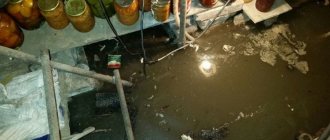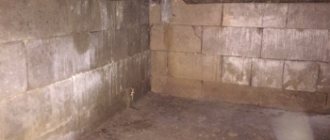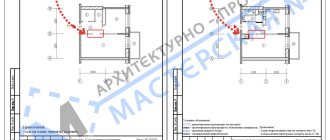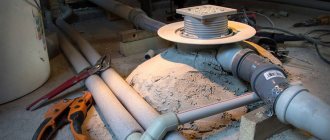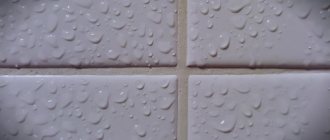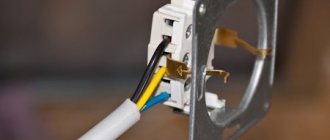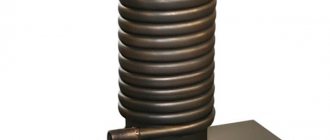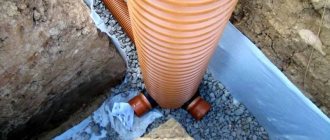Coffee capsule Nescafe Dolce Gusto Chocochino, 3 packs of 16 capsules
1305 ₽ More details
Hot chocolate capsules Nescafe Dolce Gusto Chococino, 8 servings
334 ₽ More details
Engines for garden equipment
There can be many reasons for the appearance of moisture. It is necessary to determine the factor that caused the dampness, influence it and bring the situation back to normal. In some cases, disinfection is necessary. Such complications arise due to improperly organized ventilation and waterproofing. If this is not dealt with, the problem will soon return. Much depends on the temperature in the cellar. Therefore, before drying the room, check that the ventilation pipes and waterproofing are in order.
Eliminate the causes of dampness in the basement
Why does dampness appear in the basement?
Condensation in the basement can occur for various reasons. The most common of them:
- Incorrect ventilation. The problem initially lies in errors and shortcomings in the design of the room. Because of this, basement ventilation is disrupted. The most common mistake is poor covering with slabs. Construction debris may have gotten into the ventilation pipes.
Important! If there is a temperature difference between the indoor and outdoor spaces, condensation will form on the windows and ceiling. Moisture will soon cause mold to appear.
- Groundwater has risen. This problem is relevant in spring and autumn. Heavy rains permeate the soil with moisture. This promotes humidity in the cellar. Due to poor drainage of the soil through a system of trenches and pipes, moisture in the cellar accumulates more and more.
- Cracks. Dampness in the cellar penetrates into the cellar from the soil from cracks and faults. The problem lies in an improperly structured foundation. Temperature changes will cause condensation to form. This problem leads to cracks or even collapses in the basement.
In this video we will look at the reasons for dampness in the basement:
Basement Inspection
But if the “red” alarm was not declared in vain, then it’s time to carry out a rescue operation. You need to start by clearing out the premises. All food preparations are removed from it. Then the wooden devices for storing food are disassembled.
Boxes, barrels, shelves are brought to the surface. Everything that has already absorbed moisture requires thorough drying. And this is easiest to do outdoors. And it's better on a sunny day.
Even a wooden floor will have to be dismantled if it is wet. Moreover, the boards will require a thorough inspection. If during inspection traces of rotting are found even at the initial stage, the materials are rejected without regret. The rest of the board is dried and treated with an antiseptic for further use. Can be whitened with lime.
Solution for disinfecting floorboards Source 9ban.ru
If the flooding of the basement is not yet in its final stages, then you can try to carry out light military operations, without the help of heavy artillery. To do this, all doors leading into the room are opened and left in this position for the whole day. True, this can only help in the hot summer.
And also with good ventilation. The latter is checked by burning paper. If, when it approaches the vent, inside the cellar, the flame continues to burn evenly, then the ventilation is not working. The deviation of the flames towards the hole indicates the good condition of the system.
You can try cleaning the pipes. Perhaps they are clogged. To do this, a rope is fed from the surface into the ventilation outlet. When she comes out of the vent in the basement, a pipe cleaner is tied to her. The structure is pulled through the pipe by pulling the rope back.
Cleaning the cellar ventilation Source kliningovyj-raj.ru
In addition to ventilation, a small wet spot on the wall can be dealt with in one old-fashioned way. A container with materials that can absorb moisture well is installed near the partition. This is charcoal, sawdust or lime. Salt and freshly ground coffee help a lot. The latter eliminates unpleasant symptoms. Upon completion of the operation, they should be removed from the premises.
When the problem is much more serious and the basement is badly damaged, then only radical methods will help. And they will require decisive and time-consuming action. It is necessary to clean all surfaces from dirt and fungus. After this, complete disinfection is carried out.
But if the floors are earthen, then you will have to remove a layer at least 5 cm thick. Then add dry sand. But first treat the surface with manganese.
Adding sand to floors in the cellar Source ural-resurs.su
Signs of high humidity in underground storage
There are several ways to determine high humidity in basements. The easiest one is to find the instructions for the refrigerator. The humidity level is indicated there. It is very similar to the norm in underground premises: 85-95%. A hygrometer, a device for determining the humidity of a room, will help with this.
If you do not have such a device, you can use other methods:
- Pour water into a glass. Freeze in the refrigerator overnight.
- Take it out and put it in the cellar.
- The glass will fog up. By its further condition, humidity can be determined. If the walls of the glass are dry, the humidity is reduced. If the condition has not changed, the humidity is normalized. If dripping drops appear, the humidity is increased.
But you can also find out humidity simply by looking at the general condition of the cellar:
- condensate;
- moisture on the floor;
- heavy air.
If you do not take any measures, the consequences will not please you:
- Mold and fungi will appear that can cause respiratory diseases.
- Products will begin to deteriorate.
- The walls will collapse.
Preparatory work
First you will need to remove structures and supplies. On the street, the tree must be inspected; if there are black spots, this is mold. This means that it is necessary to inspect all structures.
The shelves are laid out in the sun and dried thoroughly. Wood affected by mold must be treated with a solution of copper sulfate, the concentration of which should be no more than 10%.
If you have the funds for a new tree, it is better to replace the entire structure. Perhaps the fungus is inside, but has not yet made its way out. In this case, after treating the room and bringing the wood inside, the mold will continue to multiply.
Whitewashing with lime will help remove moisture from the cellar. This procedure is carried out before draining the basement.
You will need a 5% lime solution; it is a good disinfectant. It is poured into 2 buckets. The first part of the solution is used immediately after removing the wooden structures.
Wear gloves and goggles.
The corners are treated with a whitewash paint brush; the remaining liquid is not applied to the walls, but lime is sprayed on them. The same is done with the ceiling. It is important to coat all joints.
All surfaces of the basement are covered with tubercles. After a day or two, when the lime has dried, the procedure is repeated using the second part of the solution.
Lime retains moisture inside and prevents it from penetrating into the room. After 1-2 days, you can drain the basement.
Effective methods of control
Before you start fighting moisture, you need to determine the reasons for its appearance. All further actions depend on this. The causes can be identified by the location of the moisture.
- If on the ceiling and walls, there are problems with ventilation.
- Available only on walls; vertical waterproofing of walls is required.
- If on the floor, groundwater has increased in volume.
External waterproofing
Check the quality of installation; there may be problems with slopes and drainpipes. Possible breakdowns of the drainage system.
If you don't have any waterproofing installed at all, consider designing it. Later, protect the outer walls from moisture:
- Remove the blind areas.
- Dig 0.5 m from the walls along the entire perimeter.
- Dry the outer walls.
- Lubricate the wall with antifungal mixtures.
- Lubricate the wall with mastic, clay or concrete (one or the other).
- Install blind areas. They are fixed 0.5 m above the ground
- Fill the hole.
The installed moisture insulation system will help remove dampness.
Internal waterproofing device
In addition to the external drainage system, it is necessary to make an internal one, with the help of which the required temperature in the cellar is maintained. Procedure:
- Dry the room.
- Put the walls in order, remove the old whitewash.
- Clean out the cracks.
- Use the antifungal mixture again.
- Cover the walls with waterproofing compound.
Protect your basement from moisture
Your damp basement will no longer be like that, waterproofing will not allow excess moisture to penetrate inside.
Ventilation system
An additional ventilation system will help remove moisture in the basement. It is installed when air exchange is disrupted. There are two types of such ventilation:
- Natural. It uses the so-called. “vents” are openings throughout the room. According to the established norm, their area should correlate with the area of the entire room as 1:400.
- Forced. It is more often used in large rooms. It involves the installation of special equipment. It allows fresh air into the room when necessary.
Forced installation costs a lot.
Floor work to eliminate dampness
If moisture penetrates the walls, hits the floor and evaporates, you should also address the flooring. The floor and walls should be concreted using liquid glass and roofing felt. You can also follow a simple algorithm (if you have a clay floor):
- remove a layer of clay about 5 cm thick;
- level the floor surface and cover it with two layers of waterproofing film;
- sprinkle it with clay on top or fill it with concrete and level the surface.
In case of seasonal flooding of the area, use another method:
- Place a layer of sand or gravel about 10 cm thick on the floor to protect against groundwater flooding. Add more gravel if necessary if groundwater seeps through the drainage layer;
- Apply special waterproofing plaster to the walls;
- Place glass jars with calcium chloride in the corners of the cellar (it will absorb excess moisture). For one cellar no more than 0.5-1 kg of powder is required;
- Sprinkle the floor with quicklime in a 1 cm layer - it will absorb excess moisture and dry the room. To combat fungus and mold, you can slak the lime directly in the basement. Pour some lime into an empty container and fill it with water. The released vapors will destroy germs and mold.
During the release of lime vapors, it is better to leave the room. Return there in an hour and immediately organize ventilation for several hours.
Drying options
Drying can be done in three effective ways: using a roasting pan, a candle and a special dehumidifier.
Drying using a broiler:
- open absolutely all holes;
- put the brazier on;
- we kindle a fire in it;
- We wait until the warm air leaves the room through the open holes.
Dry the cellar with a candle. This method is simpler than the previous one, but takes much longer. It must be placed exactly under the air hood.
Dry using a desiccant. This method is used more often for large rooms. The device can show the humidity level. It is best to dry periodically, little by little.
Methods for forced drying of the cellar
All methods will require a working ventilation system. If it doesn't work well, you'll have to fix it first. Up to complete restructuring. Otherwise nothing will work. Drying should only be done in summer and hot weather.
Candle
Let's look at how to dry a basement using a regular candle. This is the easiest way to increase indoor air circulation. To do this, choose a large paraffin candle and place it on a fireproof stand. You can even just place it in a small glass jar. The structure is placed near the ventilation vent, slightly raising it above the floor.
Drying the cellar with a candle Source pixabay.com
How to prevent high humidity
In this matter, it is easier and less expensive to take preventive measures than to get rid of it. All problems can be solved if the room is designed correctly.
Basic Rules:
- The material of load-bearing walls and floors should not allow water to pass through in any state of aggregation. Use concrete of the highest grades for this.
- Be sure to carry out a waterproofing system.
- Draw a blind area around the cellar.
- Organize the ventilation system well.
- Install a vapor barrier between the main and underground rooms.
If there is mold in a wooden cellar
If the basement smells of dampness and mold has appeared on the shelves, shelves and drawers, emergency measures should be taken.
How to remove dampness and fungus from wood:
- We take out all the structures.
- We treat the walls and ceiling with a solution of soap and soda with water.
- Then we dry the room. What to do next? After which it is necessary to carry out disinfection. Lime and clay in equal quantities are dissolved in 10 liters of water, 100 g of copper sulfate is added and the shelves and drawers are treated. The floor can also be treated this way, even if it is earthen.
Then the cellar is dried. To speed up the process, install a heat gun or electric heaters in the room.
If the area is very humid, drying may take a long time. Therefore, the cellar should be ventilated daily.
You can treat wooden surfaces in the following ways:
- Take one of these products: sodium fluoride, zinc chlorine, ammonium or sodium fluoride in a volume of 30 g. The substance is diluted in hot water and all wooden structures are treated.
- How to make the paste: you will need 135 g of clay, a glass of water and 150 g of sodium fluoride. First, the chemical is added to the water, and then the clay is poured. You should get a homogeneous creamy mixture. All wooden racks, walls and drawers are treated with this composition.
Such methods will protect wooden structures from moisture and mold.
How to get rid of condensation in the cellar
Condensation can be removed in many ways. In some cases, one small action helps, in others you have to sweat.
Each type of storage has its own temperature. What temperature should be in the cellar with vegetables? The norm is considered to be no lower than 0 °C. Approximate humidity – 70-95%. It is important to maintain the necessary indicators in the cellar.
The following will help in the fight against condensation: internal and external waterproofing, vapor barrier, exhaust hood, ceiling insulation.
Folk remedies
Condensation in the garage and basement can be removed using home remedies. They are inexpensive and effective.
Humidity and condensation in the cellar - how to get rid of it:
- Dry sawdust will not completely dry out the basement, but will significantly reduce the humidity. They are poured onto the floor, shelves and in drawers. When the sawdust gets wet, add new ones.
- Before using hydrochloric acid, food and preserves are removed from the cellar. A liter of product is diluted with 10 liters of water. Wearing gloves and a mask, treat all surfaces. It is important to ensure that the hydrochloric acid solution does not get on things or your naked body. It may cause chemical burns.
- Slaked lime. After restoring the ventilation ducts or creating them, place a container with this substance in the corner of the room. Lime absorbs water. The humidity in the garage and basement will quickly disappear and condensation will disappear. Slaked lime also kills fungi in pairs. During the procedure, it is not advisable to go into the room or wear a mask. Lime vapors are not safe for human health.
- One kilogram of calcium chloride can absorb 1.5 water. It is laid out around the room and collected after 1 day (gloves and a mask are used). Then the calcium chloride is heated and can be reused. This product is also toxic, be careful with it.
- Cardboard boxes absorb water well. They are just like sawdust, laid out on the floor, and a day later they are collected and laid out with new ones. The method is cheap and effective, but it will not dry out the cellar completely. This method is only good for eliminating condensation.
- White moss powder is a great way to remove moisture. How to eliminate dampness: jars of white moss powder are placed in the corners of the cellar. This method is effective at a low percentage of humidity.
You can also make a room dry using hot clay bricks, an electric fireplace, sulfuric acid and diesel fuel.
Smoke bomb
Sulfur bombs are bought at hardware stores or wherever they sell seeds. This is an excellent remedy against parasites and fungus in the cellar.
A smoke bomb is a time-tested method of removing mold.
Advantages:
- cellar disinfection;
- disinfestation;
- extermination of rodents and moles.
The sulfur bomb warms the air in the room and saturates it with toxic smoke. During the treatment of the basement, you must leave the house or garage. There is a possibility that smoke will penetrate through the cracks into the living space, and a person may be poisoned by it if they inhale sulfuric anhydride.
Use of a smoke bomb:
- Preparation: remove metal objects, food, and canned goods from the premises. If it is impossible to remove metal structures, they are treated with grease or other viscous lubricant to avoid corrosion.
- Counting the number of sulfur bombs: 1 piece per 5–10 cubic meters of area.
- Protection: you need to wear rubber gloves, safety glasses, a respirator and tuck your hair under a hat.
- Application: place a sulfur bomb on a fireproof stand (brick, stone or foam block), light the wick and make sure that it begins to smolder. Then immediately leave the premises.
After leaving the cellar, you need to change clothes, wash your face, hands and hair. After 5 hours, the smoke bomb is removed and the room is ventilated.
